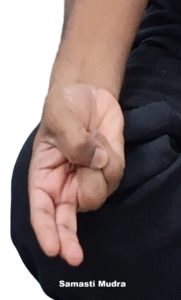Samasti Mudra (Integrating Brain Hemispheres Gesture)
Introduction
Mudras are symbolic hand gestures in yoga that regulate prana (life energy) and influence physical, mental, and spiritual well-being. Samasti Mudra is a unifying mudra that harmonizes the energies of the body and mind, promoting balance, inner calm, and spiritual integration.
The term “Samasti” in Sanskrit means “whole” or “complete,” signifying this mudra’s ability to bring together body, mind, and prana for holistic wellness. It is often practiced during meditation, pranayama, and spiritual practices to foster inner peace, unity, and energy alignment.
Meaning
Samasti = Whole, complete, integrated.
Mudra = Yogic seal or gesture.
Purpose: To unify energies within the body, promote balance, and enhance spiritual and emotional stability.
How to Perform (Practice)
Come into a sitting position, stand, and walk or lie down.
Fold down the ring and little fingers of each hand so the fingertips touch their respective palms.
Press on the backs of the bent fingers with the thumb of the same hand.
Keep your index and middle fingers extended and relaxed. Hold for 4 minutes six times daily, waiting at least 20 minutes between sessions.
Maintain the mudra for 5–15 minutes, gradually increasing duration with practice.
Benefits
Physical Benefits
Harmonizes prana flow throughout the body.
Improves circulation and energy distribution.
Supports postural alignment and relaxation of upper body muscles.
Enhances overall vitality and internal balance.
Mental & Emotional Benefits
Promotes emotional stability and mental calmness.
Reduces stress, anxiety, and mental fatigue.
Enhances focus, mindfulness, and inner awareness.
Spiritual Benefits
Encourages integration of subtle energies, supporting spiritual growth.
Strengthens heart and mind connection, promoting inner peace.
Supports meditation by aligning body, breath, and prana.
Contraindications
Finger, hand, or wrist injuries.
Shoulder or upper back issues should practice under supervision.
Avoid over-practice if hands or arms feel fatigued.
Anatomy & Physiology
Musculoskeletal: Engages intrinsic hand muscles, stabilizes fingers, and lightly involves forearm muscles.
Circulatory system: Improves blood flow to hands, forearms, and chest.
Nervous system: Activates sensory nerves, promoting parasympathetic activation and relaxation.
Endocrine system: Supports subtle energy centers related to stress regulation and balance.
Kinesiology
Fingers interlocked to form a stable unifying seal, directing energy inward.
Thumbs gently touch, supporting subtle energy circulation.
Shoulders relaxed; wrists in neutral alignment.
Enhances hand stability, proprioception, and energetic awareness.
Neurology
Stimulates peripheral nerve endings, enhancing mind-body integration.
Promotes parasympathetic activity, aiding relaxation and mental clarity.
Supports cortical areas associated with emotional regulation, focus, and awareness.
Enhances subtle energy perception and internal balance during meditation.
Duration of Mudra
Beginners: 5 minutes.
Intermediate: 10–15 minutes.
Advanced: 20–30 minutes during meditation or pranayama.
Tip: Daily practice enhances holistic balance, calmness, and energy integration.
Counter Mudra
Gyan Mudra: To combine unity with mental clarity.
Prana Mudra: To energize the body after meditation.
Apana Mudra: To release stagnant energy and promote grounding.
Conclusion
Samasti Mudra is a holistic mudra that balances body, mind, and prana, fostering emotional stability, mental clarity, and spiritual integration. Regular practice provides physical, emotional, and energetic benefits, making it ideal for meditation, pranayama, and yoga practice.
FAQ
Q1. Can beginners practice this mudra?
Yes, it is simple, safe, and suitable for all levels.
Q2. Can it help with stress or emotional imbalance?
Yes, it promotes calmness, focus, and emotional stability.
Q3. How long should it be practiced daily?
5–15 minutes for beginners; up to 30 minutes for advanced practitioners.
Q4. Can it be combined with meditation or pranayama?
Yes, it enhances meditation and pranayama practices by aligning energy flow.
References
Swami Satyananda Saraswati, Asana, Pranayama, Mudra, Bandha.
B.K.S. Iyengar, Light on Yoga.
Hatha Yoga Pradipika – Mudras for energy balance and meditation.
Gheranda Samhita – Mudras for holistic integration.
Kuvalayananda, Yoga Mimamsa Journal.

